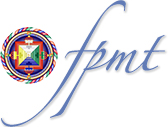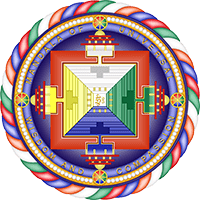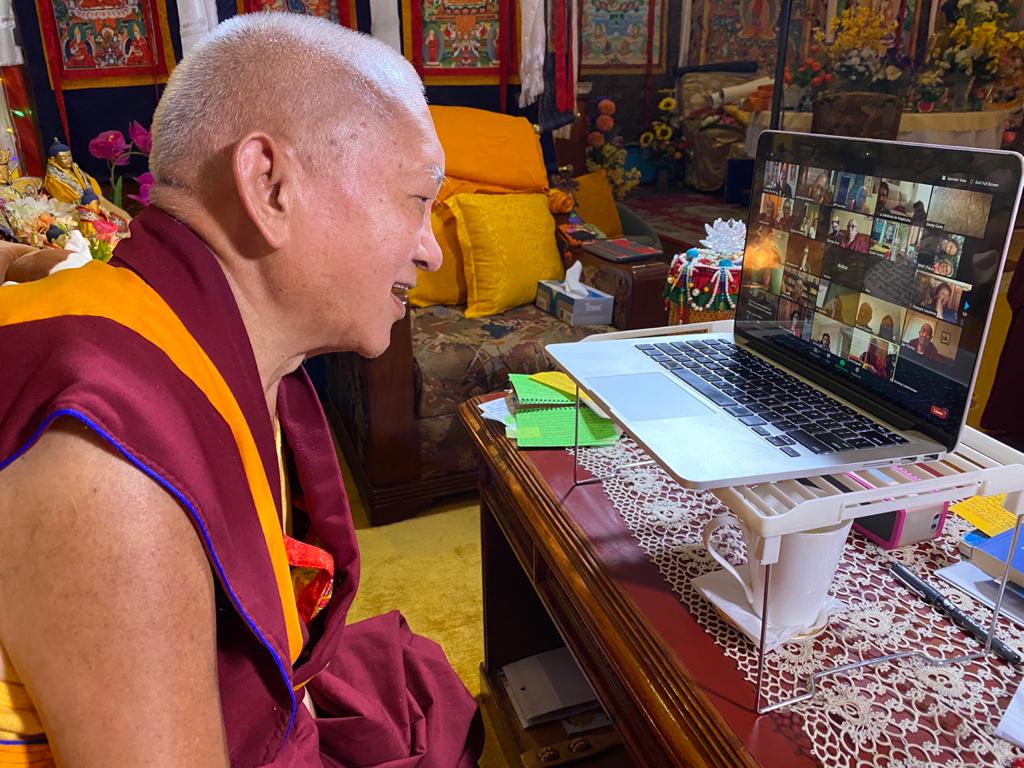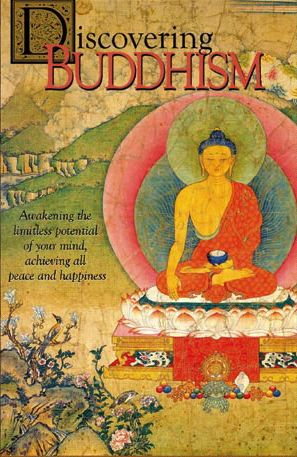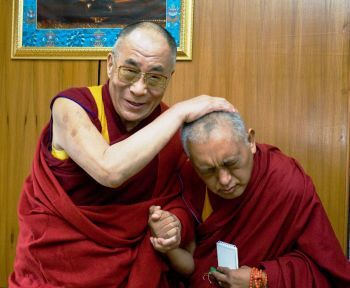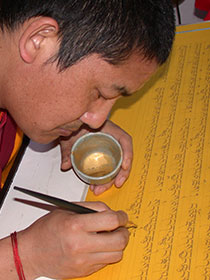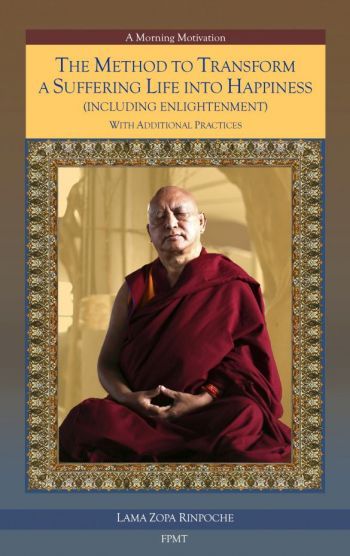- Home
- FPMT Homepage
Foundation for the Preservation of the Mahayana Tradition
The FPMT is an organization devoted to preserving and spreading Mahayana Buddhism worldwide by creating opportunities to listen, reflect, meditate, practice and actualize the unmistaken teachings of the Buddha and based on that experience spreading the Dharma to sentient beings. We provide integrated education through which people’s minds and hearts can be transformed into their highest potential for the benefit of others, inspired by an attitude of universal responsibility and service. We are committed to creating harmonious environments and helping all beings develop their full potential of infinite wisdom and compassion. Our organization is based on the Buddhist tradition of Lama Tsongkhapa of Tibet as taught to us by our founders Lama Thubten Yeshe and Lama Thubten Zopa Rinpoche.
- Willkommen
Die Stiftung zur Erhaltung der Mahayana Tradition (FPMT) ist eine Organisation, die sich weltweit für die Erhaltung und Verbreitung des Mahayana-Buddhismus einsetzt, indem sie Möglichkeiten schafft, den makellosen Lehren des Buddha zuzuhören, über sie zur reflektieren und zu meditieren und auf der Grundlage dieser Erfahrung das Dharma unter den Lebewesen zu verbreiten.
Wir bieten integrierte Schulungswege an, durch denen der Geist und das Herz der Menschen in ihr höchstes Potential verwandelt werden zum Wohl der anderen – inspiriert durch eine Haltung der universellen Verantwortung und dem Wunsch zu dienen. Wir haben uns verpflichtet, harmonische Umgebungen zu schaffen und allen Wesen zu helfen, ihr volles Potenzial unendlicher Weisheit und grenzenlosen Mitgefühls zu verwirklichen.
Unsere Organisation basiert auf der buddhistischen Tradition von Lama Tsongkhapa von Tibet, so wie sie uns von unseren Gründern Lama Thubten Yeshe und Lama Thubten Zopa Rinpoche gelehrt wird.
- Bienvenidos
La Fundación para la preservación de la tradición Mahayana (FPMT) es una organización que se dedica a preservar y difundir el budismo Mahayana en todo el mundo, creando oportunidades para escuchar, reflexionar, meditar, practicar y actualizar las enseñanzas inconfundibles de Buda y en base a esa experiencia difundir el Dharma a los seres.
Proporcionamos una educación integrada a través de la cual las mentes y los corazones de las personas se pueden transformar en su mayor potencial para el beneficio de los demás, inspirados por una actitud de responsabilidad y servicio universales. Estamos comprometidos a crear ambientes armoniosos y ayudar a todos los seres a desarrollar todo su potencial de infinita sabiduría y compasión.
Nuestra organización se basa en la tradición budista de Lama Tsongkhapa del Tíbet como nos lo enseñaron nuestros fundadores Lama Thubten Yeshe y Lama Zopa Rinpoche.
A continuación puede ver una lista de los centros y sus páginas web en su lengua preferida.
- Bienvenue
L’organisation de la FPMT a pour vocation la préservation et la diffusion du bouddhisme du mahayana dans le monde entier. Elle offre l’opportunité d’écouter, de réfléchir, de méditer, de pratiquer et de réaliser les enseignements excellents du Bouddha, pour ensuite transmettre le Dharma à tous les êtres. Nous proposons une formation intégrée grâce à laquelle le cœur et l’esprit de chacun peuvent accomplir leur potentiel le plus élevé pour le bien d’autrui, inspirés par le sens du service et une responsabilité universelle. Nous nous engageons à créer un environnement harmonieux et à aider tous les êtres à épanouir leur potentiel illimité de compassion et de sagesse. Notre organisation s’appuie sur la tradition guéloukpa de Lama Tsongkhapa du Tibet, telle qu’elle a été enseignée par nos fondateurs Lama Thoubtèn Yéshé et Lama Zopa Rinpoché.
Visitez le site de notre Editions Mahayana pour les traductions, conseils et nouvelles du Bureau international en français.
Voici une liste de centres et de leurs sites dans votre langue préférée
- Benvenuto
L’FPMT è un organizzazione il cui scopo è preservare e diffondere il Buddhismo Mahayana nel mondo, creando occasioni di ascolto, riflessione, meditazione e pratica dei perfetti insegnamenti del Buddha, al fine di attualizzare e diffondere il Dharma fra tutti gli esseri senzienti.
Offriamo un’educazione integrata, che può trasformare la mente e i cuori delle persone nel loro massimo potenziale, per il beneficio di tutti gli esseri, ispirati da un’attitudine di responsabilità universale e di servizio.
Il nostro obiettivo è quello di creare contesti armoniosi e aiutare tutti gli esseri a sviluppare in modo completo le proprie potenzialità di infinita saggezza e compassione.
La nostra organizzazione si basa sulla tradizione buddhista di Lama Tsongkhapa del Tibet, così come ci è stata insegnata dai nostri fondatori Lama Thubten Yeshe e Lama Zopa Rinpoche.
Di seguito potete trovare un elenco dei centri e dei loro siti nella lingua da voi prescelta.
- 欢迎 / 歡迎
简体中文
“护持大乘法脉基金会”( 英文简称:FPMT。全名:Foundation for the Preservation of the Mahayana Tradition) 是一个致力于护持和弘扬大乘佛法的国际佛教组织。我们提供听闻,思维,禅修,修行和实证佛陀无误教法的机会,以便让一切众生都能够享受佛法的指引和滋润。
我们全力创造和谐融洽的环境, 为人们提供解行并重的完整佛法教育,以便启发内在的环宇悲心及责任心,并开发内心所蕴藏的巨大潜能 — 无限的智慧与悲心 — 以便利益和服务一切有情。
FPMT的创办人是图腾耶喜喇嘛和喇嘛梭巴仁波切。我们所修习的是由两位上师所教导的,西藏喀巴大师的佛法传承。
繁體中文
護持大乘法脈基金會”( 英文簡稱:FPMT。全名:Found
ation for the Preservation of the Mahayana Tradition ) 是一個致力於護持和弘揚大乘佛法的國際佛教組織。我們提供聽聞, 思維,禪修,修行和實證佛陀無誤教法的機會,以便讓一切眾生都能 夠享受佛法的指引和滋潤。 我們全力創造和諧融洽的環境,
為人們提供解行並重的完整佛法教育,以便啟發內在的環宇悲心及責 任心,並開發內心所蘊藏的巨大潛能 — 無限的智慧與悲心 – – 以便利益和服務一切有情。 FPMT的創辦人是圖騰耶喜喇嘛和喇嘛梭巴仁波切。
我們所修習的是由兩位上師所教導的,西藏喀巴大師的佛法傳承。 察看道场信息:
- FPMT Homepage
- News/Media
-
- Study & Practice
-
-
- About FPMT Education Services
- Latest News
- Programs
- New to Buddhism?
- Buddhist Mind Science: Activating Your Potential
- Heart Advice for Death and Dying
- Discovering Buddhism
- Living in the Path
- Exploring Buddhism
- FPMT Basic Program
- FPMT Masters Program
- FPMT In-Depth Meditation Training
- Maitripa College
- Lotsawa Rinchen Zangpo Translator Program
- Universal Education for Compassion & Wisdom
- Online Learning Center
-
- Prayers & Practice Materials
- Overview of Prayers & Practices
- Full Catalogue of Prayers & Practice Materials
- Explore Popular Topics
- Benefiting Animals
- Chenrezig Resources
- Death & Dying Resources
- Lama Chopa (Guru Puja)
- Lama Zopa Rinpoche: Compendium of Precious Instructions
- Lama Zopa Rinpoche: Life Practice Advice
- Lama Zopa Rinpoche Practice Series
- Lamrim Resources
- Mantras
- Prayer Book Updates
- Purification Practices
- Sutras
- Thought Transformation (Lojong)
- Audio Materials
- Dharma Dates - Tibetan Calendar
- Translation Services
- Publishing Services
- Ways to Offer Support
- Prayers & Practice Materials
-
- Teachings and Advice
- Find Teachings and Advice
- Lama Zopa Rinpoche Advice Page
- Lama Zopa Rinpoche: Compendium of Precious Instructions
- Lama Zopa Rinpoche Video Teachings
- ༧སྐྱབས་རྗེ་བཟོད་པ་རིན་པོ་ཆེ་མཆོག་ནས་སྩལ་བའི་བཀའ་སློབ་བརྙན་འཕྲིན།
- Podcasts
- Lama Yeshe Wisdom Archive
- Buddhism FAQ
- Dharma for Young People
- Resources on Holy Objects
- Teachings and Advice
-
-
*If a menu item has a submenu clicking once will expand the menu clicking twice will open the page.
-
-
- Centers
-
- Teachers
-
- Projects
-
-
-
-
*If a menu item has a submenu clicking once will expand the menu clicking twice will open the page.
-
-
- FPMT
-
- Shop
-
-
-
The Foundation Store is FPMT’s online shop and features a vast selection of Buddhist study and practice materials written or recommended by our lineage gurus. These items include homestudy programs, prayers and practices in PDF or eBook format, materials for children, and other resources to support practitioners.
Items displayed in the shop are made available for Dharma practice and educational purposes, and never for the purpose of profiting from their sale. Please read FPMT Foundation Store Policy Regarding Dharma Items for more information.
-
-
13
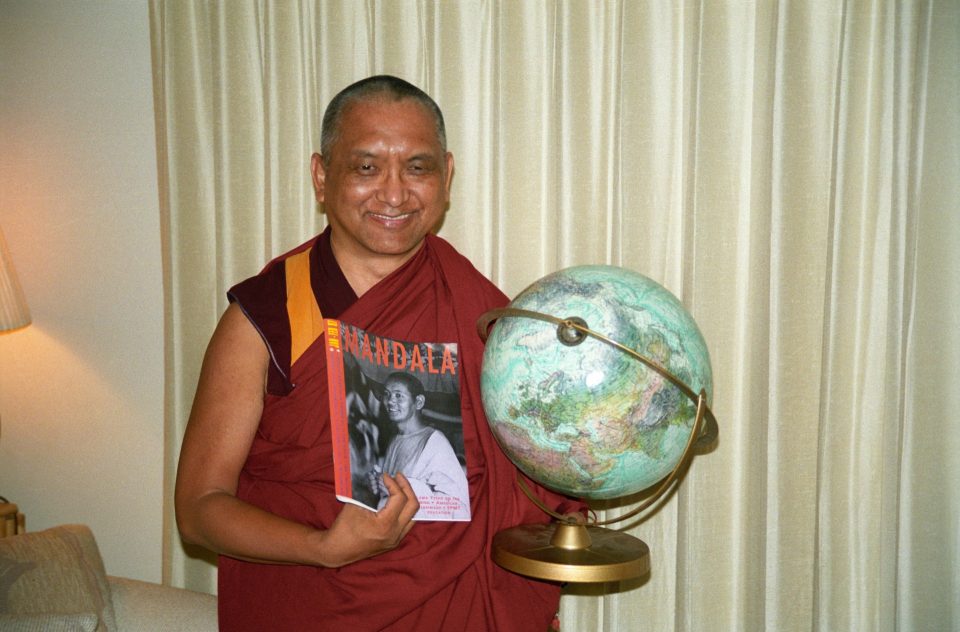
Lama Zopa Rinpoche in California, 1997. Photo by Ven. Roger Kunsang.
Over the years, students have shared stories from Lama Zopa Rinpoche’s travels around the world benefiting others; to offer a glimpse into what it is like to be on the road with Rinpoche, and to witness and participate in Rinpoche’s enlightened activity. These stories offer a glimpse into how Rinpoche used all of the circumstances in daily life, including the time traveling, to practice Dharma and serve others. Today we are sharing a report from 1997 from long-time FPMT student and former director of FPMT Education Services, Merry Colony.
The summer of ’97 could well indicate a new beginning in the travel style of Lama Zopa Rinpoche. Certainly, given the advice of one of his main teachers Ribur Rinpoche and others regarding Rinpoche’s hectic touring schedules and the consequent toll on his health, we should all pray for such.
At a slower pace, with greater autonomy and fewer scheduled events, Roger Kunsang, Roger Munro and our precious Rinpoche left California in the first days of August and embarked on the USA tour, but this time in a luxury conversion Dodge Ram van, maroon of course, complete with custom seats, TV and VCR. On this tour there would not be the constant hum of departure gate announcements, delays at baggage claim carousels or curbside’s anxious check-in crowds. Nor would there be the khatas given in haste amongst rushing onlookers. A great start to what can hopefully become the downsizing of Lama Zopa Rinpoche’s annual travel agenda.
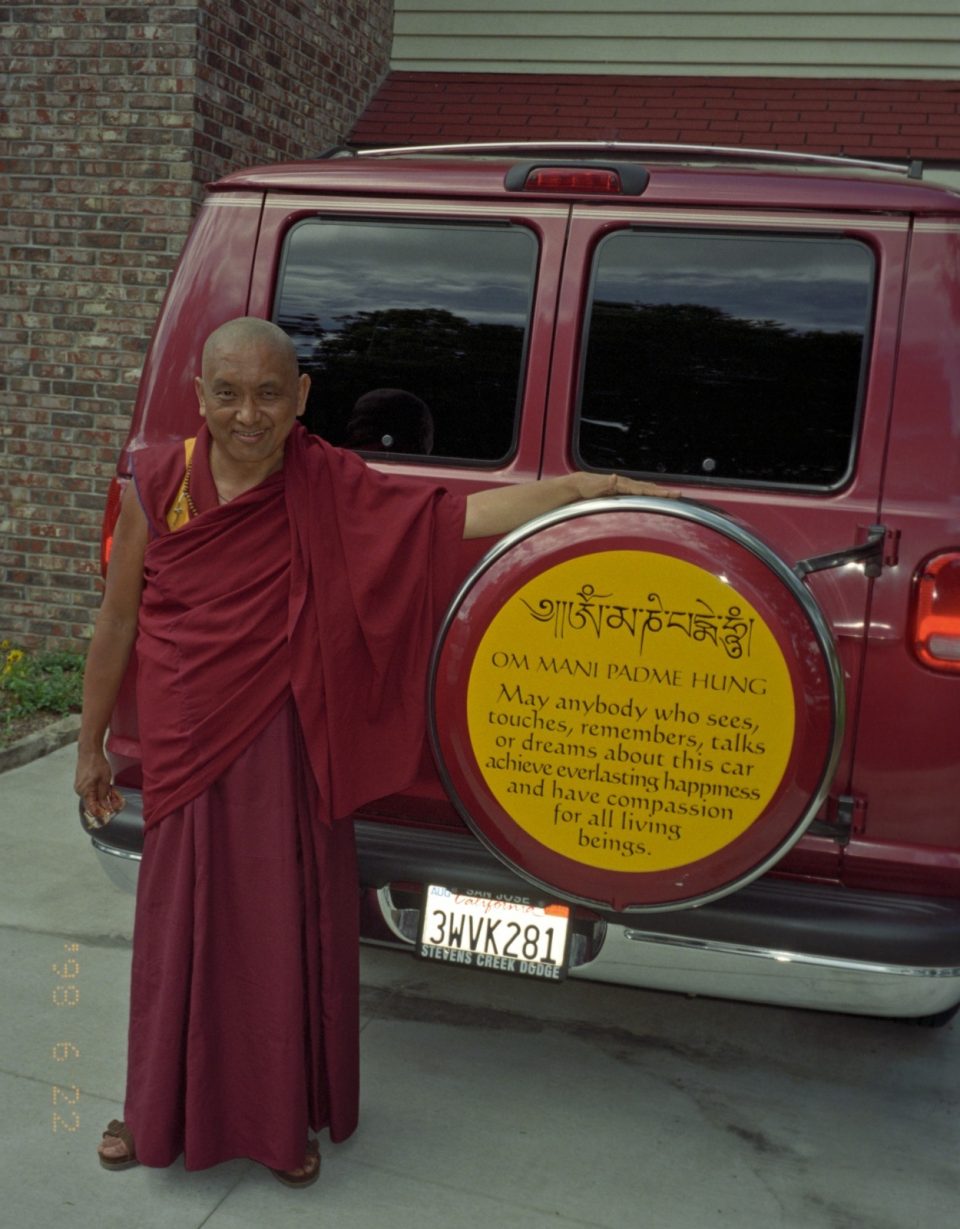
Rinpoche always taking every opportunity from daily life to bless others: The “vajra vehicle” Dodge van, 1998. Photo by Ven. Roger Kunsang.
As a method for giving teaching to us, the style in which Rinpoche traveled, ate and rested provided a whole new market of opportunities for him to show us how to create merit amidst the more ordinary scenery of daily life. The most consistent way in which Rinpoche did this, Roger Munro said, was to make the environment, at every moment, were, into a merit field. That Dodge van, be assured, was power-packed, bestowing blessings on all who were in its reach and providing those within with the means to create merit almost effortlessly. And if there is anything that comes close to death as being a definite in our lives, it is that we will ride in our vehicles. So how to use them for merit? Fill them with holy objects and then circumambulate them at rest strops, parking lots and shopping malls. That’s what Rinpoche did!
The route the entourage followed, starting off in Santa Cruz in California, was first through Nevada where the first night was spent on the side of the road, Rinpoche sitting up all night on the platform bed inside the van, Ven. Roger and Roger on the ground outside. When Roger 2 awoke in the morning, a bit disoriented, the first utterance he made was, “Where are we?” From inside the van a muffled voice replied, “In hell!” For the most part, however, Rinpoche remained quiet as they drove through the desert of Nevada, except to remark now and then on how a particular mountain “looked angry” or another “like an animal with its skin ripped off.” In Arizona Rinpoche was asked if he would like to see the Grand Canyon. “A hole in the ground! What for?” he replied.
When they reached Salt Lake City, Utah the atmosphere within the vajra vehicle and in the surrounding environment changed. There were several rainbows and a thin white cloud resting on the mountains surrounding the city, “as if a kata were draped on them,” Roger M. said. Rinpoche commented that the local deities seemed pleased and then got out to inspect the salt lake, the first interest he’d actively taken in the scenery so far. Roger M. reflected on how in his previous life the Lawudo Lama had made trips by foot to Tibet to buy salt. There may well have been a connection as Rinpoche seemed very interested in how and why and what kind of salt was there. After a visit with the family of Gomo Tulku they continued on to Wyoming and then Nebraska.
It was here, in the flatlands of middle America, that Rinpoche gave one of his best teachings. As it happened there was a Wheel Turning Day, August 7, when all the merits accumulated were multiplied ten million times. There were no stupas nearby, no statues, no Dharma centers. Except of course the unbelievably powerful objects that Rinpoche carries with him, and needless to say Rinpoche’s holy body itself. Within an hour the Motel 8 room where they had spent the previous night was transformed into a gompa and other than to eat lunch in the park nearby and bless the sentient beings living in the Platt river, the three did not leave the hotel room/gompa all day. They circumambulated a small formica table in the room adorned with their mani wheels, statues and the most precious stupa Rinpoche carries containing the Buddha’s relic. They prostrated to the makeshift altar where Rinpoche had set up laminated sheets of Lama Tsong Khapa and Medicine Buddha. And all around they set up water bowls, of the plastic Park Inn variety courtesy of the motel. Then they meditated on the purpose of the perfect human life, and making it worthwhile by accumulating merit on behalf of sentient beings and dedicating all the merits to them. The example shown has to make us ask: Is there really that much I need to make my life worthwhile?
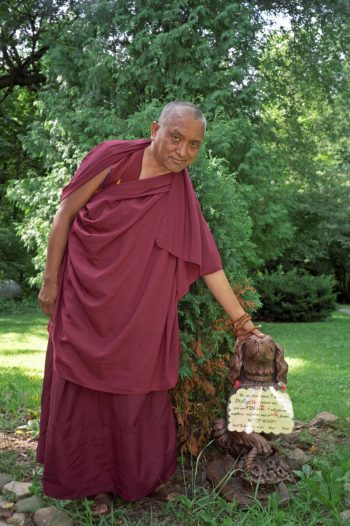
Dog with Dharma message written by Lama Zopa Rinpoche at Deer Park, Wisconsin, USA, 1997. Photo by Ven. Roger Kunsang.
The next stop was Deer Park, Wisconsin, the home of Geshe Sopa Rinpoche, one of Lama Zopa Rinpoche’s teachers. The entourage spent twelve days here, Rinpoche receiving teachings for two hours every day from Geshe-la. At the end Rinpoche offered a long life puja for Geshe Sopa, for which he shopped at the local department store, buying among other things, an Edgewood dinner set. The tsog offering was three tiers of gaudy supermarket cake, one of which had a smily face decorated in three-inch- thick frosting. Geshe-la was extremely pleased. When it came to the part in the puja where the mandala is offered and an original memorized praise is recited to the Lama, the tables were untraditionally turned. Rather than Lama Zopa offering the praise, Geshe Sopa himself spoke a moving praise of Lama Zopa’s extraordinary qualities as a yogi-practitioner. Before leaving Deer Park Rinpoche granted the Vajrasattva empowerment, at the request of Geshe Sopa, to the many students of Geshe-la who were present.
On to Decatur, Illinois. At Tilopa Center Rinpoche taught for three nights on The Three Principal Aspects of the Path followed by a Four-Armed Chenrezig empowerment. At a picnic Rinpoche is known to have given his first tattoo. On the forearm of a tattoo artist Rinpoche wrote, “The moment you remember death all other problems will be solved.” The man went home that night and put the needle and ink to the words. Yet another skillful means of bringing the teachings into our daily life American reality.
By now Ven. Tsenla had joined Rinpoche’s entourage and they drove back West to Osel Shen Phen Ling in Missoula, Montana. Director Deanna Sheriff wrote, “Rinpoche transformed our environment and all who came in touch with him. He has challenged us to build a stupa in Montana for the benefit of all who live here and particularly for the growing Tibetan community. We are delighted to fulfill his vision for us. We are also trying to hold Rinpoche’s vision of a bigger center in our visualizations and we invite students worldwide to pray for our success.” The vajra mobile then headed to the Dharma Friendship Foundation in Seattle for a Vajrasattva empowerment and public talk, then on to San Francisco for another Vajrasattva empowerment sponsored by Tse Chen Ling Center and attended by 200 people.
Being the first stop of a month-long program in California, S an Francisco saw the beginnings of an international audience with several Taiwanese in attendance. From there the venue moved south to Cupertino’s Medicine Buddha’s Healing Center. Here the numbers swelled, with students that had come from New Zealand, Europe, Nepal and Taiwan for the Heruka and Vajra Yogini initiations preceded each night by extensive lam-rim teachings. Rinpoche used Lama Yeshe’s text for the Heruka and would periodically read notes to us that Lama written as well as stopping where Lama had stopped when he had given the initiation years ago. It was a heartfelt touch for those of us who had attended those very memorable initiations.
Land of Medicine Buddha in Soquel hosted the next event, a Palden Lhamo empowerment. Co-director Mark Gatter tells of having lunch with Rinpoche the day of the empowerment when it was discovered that Rinpoche didn’t actually have the text with him. This inspired several Roger-powered long distance cellphone calls from the table until a text was located in Australia. They then returned to the center where the text was faxed through. Only when Rinpoche had started the preparation was it discovered that there were some pages missing. More calls to Australia. Just then three monks from Nalanda Monastery in France arrived, one of them carrying the exact text Rinpoche was in need of. He had brought it as an auspicious offering to the guru! Said Mark: “Don’t you just love this stuff?” The initiation then proceeded without a hitch, the gompa filled with students from all over the world, finishing at 5am.
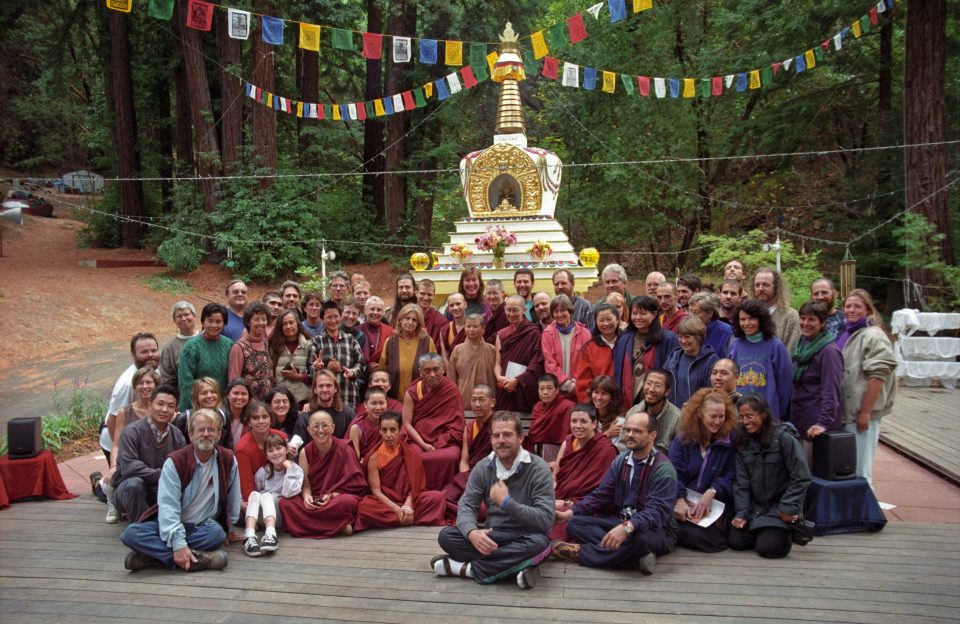
Lama Zopa Rinpoche with Most Secret Hayagriva retreat group at Vajrapani Institute, 1997. Photo by Ven. Roger Kunsang.
And now we bring you to date, where, as of writing, nearby at Vajrapani Institute, the extremely auspicious Dharma event of seventy students and Rinpoche doing a Most Secret Hayagriva retreat is in its final days. Many in attendance had followed the eight days of initiations preceding the retreat which had finished each night between 3 and 5am. When on the first day of retreat Rinpoche announced that this was “not going to be picnic,” a slight panic could be felt in the room. Picnic it hasn’t been (in fact meals have been taken in silence and without undue lagging about). Spiritual feast is more the description. At the start, however, it looked as though Rinpoche may depart early and go to Dharamsala for teachings from His Holiness, but the decision to stay was made when Geshe Sopa advised Rinpoche to remain. From our hearts, thank you Geshe-la!
For twenty-four days, now, we have had the indescribable fortune of getting a taste for how the guru would have us meditate and conduct ourselves in retreat. First session at 5am, as with all sessions, began with extensive motivation and prostrations to the Thirty-five Buddhas followed usually by commentary and then the sadhana either chanted in Tibetan or done silently in one’s own language. Rinpoche had invited Sera Je Geshe Thubten Sonam to come as our puja leader. After session and breakfast 1000 water bowls were offered at the stupa of the most precious Lama Thubten Yeshe. Another session began at 9:30am and another at 3pm. The evening session at seven included commentary as well as extensive torma and tsog offerings. After sometimes forty-five minutes of Rinpoche’s elaborate dedication prayers, we usually got to bed well after midnight.
The amazing thing to experience was how our resistance to the heavy schedule became less and less, and while tiredness always lurked around the edges, it was very sustainable, and it even became enjoyable to be making such effort to make our lives meaningful.
We even had the merit to walk out of the gompa one session and see a seventeen-foot Medicine Buddha tangka hanging from the redwoods behind Lama’s stupa. This was Peter Iseli’s most recent offering (for nearby Land of Medicine Buddha), and Rinpoche honored him that night with praise and presents after extensive offerings and prayers had been made to the tangka Buddhas.
On the last morning of retreat Rinpoche explained that only since his being in the USA did the plan to do this Most Secret Hayagriva retreat take shape. He also said that he did not expect there to be as much interest as there was and that he was pleased with how the retreat went.
Rinpoche then said that he would like to dedicate the positive accumulation to His Holiness. A letter will be sent to His Holiness explaining that this is the first time in the West that a group has done this particular practice and that we would all like to dedicate the merits to be guided by the Compassionate Buddha in all our lives and never to be separate.
Finally Rinpoche paid tribute to Paula Chichester and Roger Munro, who are about to begin their second three-year retreat. “Bearing so much hardship, this is what I am most interested in. Generally people who have done three-year retreat, you don’t see much result, but I can see the improvement, stability. This is the result of having practiced Dharma during the retreat. Anyone can recite mantras but practicing Dharma is very difficult. When there is no development in the mind it is not because one doesn’t have mantras to recite or deity practice to do, it is because no Dharma practice gets done.” Rinpoche wished them both a good journey.
Tomorrow is fire puja and then as we all came together so we will part, each to their to their own destination, to their next work. We dedicate all the merits to all the FPMT students, benefactors, teachers and projects. That all may have success and that all obstacles be cleared.
And most of all that our lamas who show us the path, without whom we would not even know the name of Buddha, will have long and healthy lives and that all their holy wishes may be fulfilled without delay.
Written by Merry Colony for Mandala magazine, November-December 1997.
You can read more inspiring and amusing stories of Lama Zopa Rinpoche on the road we have previously published.
Foundation for the Preservation of Mahayana Tradition (FPMT), is a Tibetan Buddhist organization dedicated to the transmission of the Mahayana Buddhist tradition and values worldwide through teaching, meditation and community service.
- Home
- News/Media
- Study & Practice
- About FPMT Education Services
- Latest News
- Programs
- New to Buddhism?
- Buddhist Mind Science: Activating Your Potential
- Heart Advice for Death and Dying
- Discovering Buddhism
- Living in the Path
- Exploring Buddhism
- FPMT Basic Program
- FPMT Masters Program
- FPMT In-Depth Meditation Training
- Maitripa College
- Lotsawa Rinchen Zangpo Translator Program
- Universal Education for Compassion & Wisdom
- Online Learning Center
- Prayers & Practice Materials
- Overview of Prayers & Practices
- Full Catalogue of Prayers & Practice Materials
- Explore Popular Topics
- Benefiting Animals
- Chenrezig Resources
- Death & Dying Resources
- Lama Chopa (Guru Puja)
- Lama Zopa Rinpoche: Compendium of Precious Instructions
- Lama Zopa Rinpoche: Life Practice Advice
- Lama Zopa Rinpoche Practice Series
- Lamrim Resources
- Mantras
- Prayer Book Updates
- Purification Practices
- Sutras
- Thought Transformation (Lojong)
- Audio Materials
- Dharma Dates – Tibetan Calendar
- Translation Services
- Publishing Services
- Teachings and Advice
- Find Teachings and Advice
- Lama Zopa Rinpoche Advice Page
- Lama Zopa Rinpoche: Compendium of Precious Instructions
- Lama Zopa Rinpoche Video Teachings
- ༧སྐྱབས་རྗེ་བཟོད་པ་རིན་པོ་ཆེ་མཆོག་ནས་སྩལ་བའི་བཀའ་སློབ་བརྙན་འཕྲིན།
- Podcasts
- Lama Yeshe Wisdom Archive
- Buddhism FAQ
- Dharma for Young People
- Resources on Holy Objects
- Ways to Offer Support
- Centers
- Affiliates Area
- Teachers
- Projects
- Charitable Projects
- Make a Donation
- Applying for Grants
- News about Projects
- Other Projects within FPMT
- Support International Office
- Projects Photo Galleries
- Give Where Most Needed
- FPMT
- Shop
Translate*
*powered by Google TranslateTranslation of pages on fpmt.org is performed by Google Translate, a third party service which FPMT has no control over. The service provides automated computer translations that are only an approximation of the websites' original content. The translations should not be considered exact and only used as a rough guide.Tibetan Buddhism teaches you to overcome your dissatisfied mind, but to do that you have to make an effort. To put our techniques into your own experience, you have to go slowly, gradually. You can’t just jump right in the deep end. It takes time and we expect you to have trouble at first. But if you take it easy it gets less and less difficult as time goes by.
